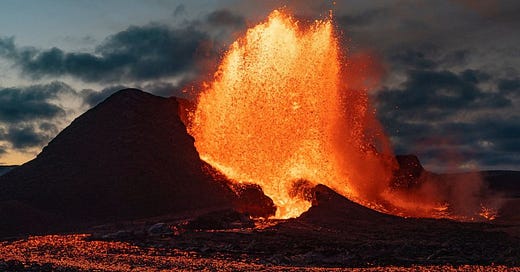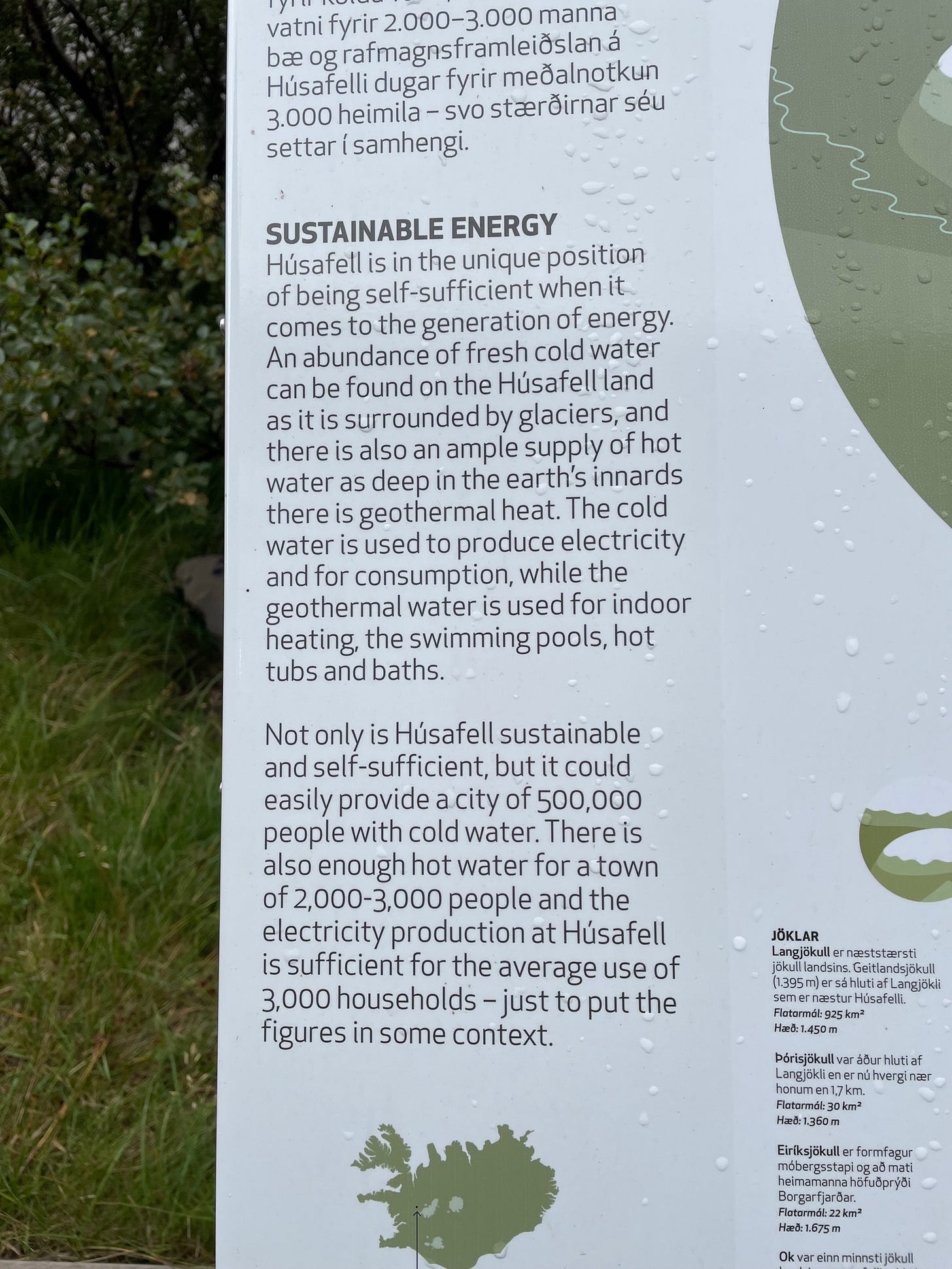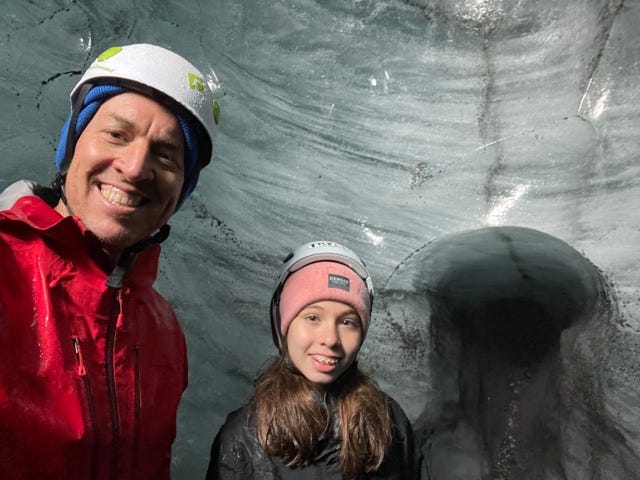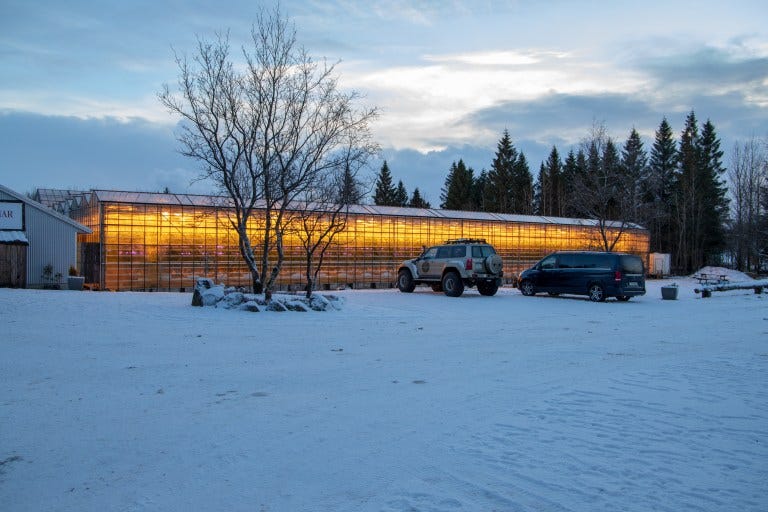We come from the land of the ice and snow
From the midnight sun where the hot springs flow
Robert Plant wrote those lyrics when Zeppelin performed in Reykjavik in 1970. I’ve been writing in Iceland as well, touring waterfalls and glaciers in a camper van with my 12yo daughter Annalise. I’m typing these words near the Fagradalsfjall volcano, mesmerized by the eruption’s live feed.
Creativity often strikes me when an idea from one context is applied to another. The inspiration for BrightFarms struck when I imagined the original business model of (Brian and Jigar’s) SunEdison applied to produce and supermarkets.
After a hike several days ago, I enjoyed a beer with my friend (and world class Iceland tour guide) Villi Friðriksson at the Hotel Húsafell, which produces 100% of its hot water and energy on site with no carbon emissions. See the images below for Húsafell’s sustainability story.
Húsafell is not unique in Iceland, which has glaciers on top of volcanos, so there are immense quantities of underground heat and huge consistent flows of melted glacier water.
Icelanders run lights and hot water with abandon at no environmental cost. There are no utility scale windmills in Iceland because they don’t need more clean renewable energy.
It wasn’t always this way. Until the 1970s, most of Iceland’s energy came from imported fossil fuels.
What does that mean for the food system? One example is Friðheimar, an Icelandic greenhouse farm company that supplies 40% of Iceland’s tomato market. The long dark cold Icelandic winters require extraordinary heating and artificial lighting to successfully grow tomatoes. But there are zero emissions at Friðheimar from heating, artificial lighting and other electricity consumption.
Iceland, by the way, isn’t just growing lettuces and tomatoes in controlled environments. My daughter and I also enjoyed greenhouse-grown raspberries, strawberries, lettuces, and peppers. All of it locally grown, delicious, sustainable, and a source of pride for Icelanders.
How can Friðheimar achieve complete carbon neutrality?
Trucks move goods around Iceland, including the tomatoes. When I asked Friðheimar owner and manager Knútur Friðheimar whether he thought Iceland would/could electrify trucking (which would make transportation carbon neutral), he was optimistic, pointing out that Iceland only lags Norway for the national conversion to electric vehicles. A taxi driver in Reykjavik was similarly optimistic, describing how the combination of high gas prices with low electricity rates made it economical to electrify taxi fleets.
Knútur is less sure about carbon emissions in the fertilizer he imports from overseas. And, of course, his packaging and other supplies are subject to manufacturing and shipping emissions. Friðheimar is therefore in the same boat as most of us for a small portion of their emissions, and so to get to 100% carbon neutrality will require improvements in other parts of their supply chains.
Iceland is small island country with unique resources that won’t be easy to mimic. But here, in the land of fire and ice, I’m inspired to consider a future United States growing more of our food indoors with no fossil fuels.
Of course we don’t have volcanos under our feet in most of the U.S. But this sort of power might not be out of reach. Consider that China has the world’s biggest geothermal heating system (supplying over 1 million customers), and one of Europe’s largest geothermal district heating systems is in Paris. The United States has the potential for significantly more geothermal heat and electricity production.
In addition, next generation nuclear power could fulfill the role of volcanoes in providing Americans with clean, powerful and carbon free heat and electricity.
Even if geothermal and nuclear don’t solve the problem, America is on a path to electrifying everything with clean renewable (and cheaper) energy. It is inexorable that we’ll convert our vehicles to electric.
So it’s not hard to imagine the greenhouse industry in the U.S. growing and shipping produce with zero emissions across a number of produce categories.
I just want us to get there faster! All these changes cannot be achieved by innovative food companies alone. We’ll need coordinated planning among local, state and federal governments, utilities, private companies and the public. See this U.N. report for how Iceland became a leader in this field. Let’s do it!
Product Review: Friðheimar “Islenskir Piccolotomatar” Tomatoes
The signature tomato soup at the restaurant inside the Friðheimar greenhouse was terrific. But I was particularly impressed with their simple cherry tomatoes I sampled in Villi’s Icelandic home. My 12yo daughter Annalise said they were like regular tomatoes, but extra! They were super delicious. And gown with hardly any carbon emissions. The waterfalls in Iceland are pretty good also!
Extra: BrightFarms Acquired by Cox Enterprises
I’m thrilled that BrightFarms, the company I founded in 2011, was just acquired by Cox Enterprises. Cox is a company aligned with the mission of BrightFarms and in sync with our values. BrightFarms and Cox are IMO a perfect match. The resources of Cox will enable BrightFarms to more quickly scale to meet the needs of U.S. consumers. I couldn’t be happier.
The best days of BrightFarms surely still lie ahead, so there is lots of work to do still, and I’ll still be on the team supporting my fellow BrightFarmers.
In the meantime, I want to say thank you from the bottom of my heart to everyone who supported me along this journey to this milestone.
I expect to lean further into Negative Foods matters going forward. I’ll accelerate the book, spend more time looking for investment opportunities, and begin public speaking on matters related to food brands with carbon neutral/negative footprints.
Keep sending your ideas!
For Your Further Consideration:
Tractors Finally Get the Tesla Treatment
Cargill, Microsoft join $17m round for carbon verification platform Regrow
Regenerative Agriculture Can Change Your Life
Soup-To-Nuts Podcast: How do consumers think about sustainability when buying groceries?
The views in this newsletter belong solely to Paul Lightfoot (and not to BrightFarms or other organizations). This newsletter accepts no advertising. Learn more about this newsletter at https://paullightfoot.substack.com/about.










